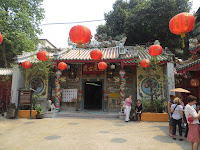 Well, the blog has been pushed to the side in the face of a big move…My husband's company offered him another opportunity in Shanghai, China, so over the past few months, we have visited Shanghai, found a new home, packed up our belongings in China and moved to Shanghai!
Well, the blog has been pushed to the side in the face of a big move…My husband's company offered him another opportunity in Shanghai, China, so over the past few months, we have visited Shanghai, found a new home, packed up our belongings in China and moved to Shanghai!
China presents another part of the world to explore and discover, a new language to learn (Mandarin) and new places to visit…
I thought that living in Thailand was a bit challenging, but compared to China, in many ways it was much easier. China has a population of nearly 1.4 billion, which is almost 20% of the world's population, and just under 30 million of that population are our neighbors in Shanghai! You never feel alone in China! There are always crowds…always a new face to meet!
We needed 3 different visas to move to China - one to visit to choose a new home, one to temporarily move and one permanent visa. I thought we had red tape back in the States, but you haven't seen red tape until you move to China! What makes everything a bit more challenging is the language barrier. Many Chinese don't speak English, or if they do understand, they won't try to speak it because they are afraid of "losing face" or looking bad. For a foreigner, that makes knowing a bit of Mandarin very useful. Many of the older Chinese were brought up during a time when any outsider was not welcome in their country, and it is not difficult to understand that they are still wary of outsiders…the younger generation has been brought up in a country that has changed considerably, and they are becoming more open and interested in becoming part of the greater global world…

China is such a world of contrasts, especially in Shanghai. There is great wealth, standing side by side with great poverty. Because of the one child policy, there is a great disregard for children who are born with handicaps. We live in an incredibly modern city but where one cannot drink the water out of the taps because of unsanitary conditions. Pollution is a huge problem, and one that the Chinese government is trying to deal with. Much of China still burns coal for heating, and that is a big part of the problem.
I will continue to write about my thoughts and impressions of China and of my travels around the world.




















































